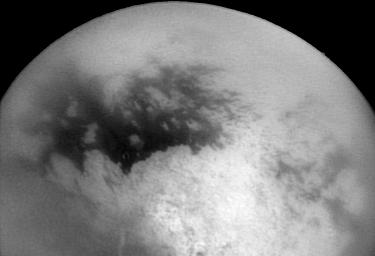Second Titan Targeted Flyby #1
Caption:
This image was taken on Dec. 11, 2004 by the Cassini spacecraft as it approached Titan for its second close encounter with this intriguing moon.
The bright and dark regions near the center of the frame are features on Titan's surface. The image has been processed to make features more visible. The surface contrast is degraded toward the edges of the disk due to the effects of Titan's smoggy atmosphere. The region seen here is similar to that seen during Cassini's first close flyby of Titan in October (see
PIA06141
). The bright area toward the bottom of the image is the region dubbed "Xanadu." North is to the upper right.
The image was acquired with the Cassini spacecraft narrow angle camera at a distance of approximately 810,000 kilometers (503,000 miles). The image scale is 4.8 kilometers (3 miles) per pixel.
Background Info:
The Cassini-Huygens mission is a cooperative project of NASA, the European Space Agency and the Italian Space Agency. The Jet Propulsion Laboratory, a division of the California Institute of Technology in Pasadena, manages the Cassini-Huygens mission for NASA's Office of Space Science, Washington, D.C. The Cassini orbiter and its two onboard cameras, were designed, developed and assembled at JPL. The imaging team is based at the Space Science Institute, Boulder, Colo.
For more information, about the Cassini-Huygens mission visit,
http://saturn.jpl.nasa.gov
and the Cassini imaging team home page,
http://ciclops.org
.
Cataloging Keywords:
| Name |
Value |
Additional Values |
| Target |
Titan |
|
| System |
Saturn |
|
| Target Type |
Satellite |
|
| Mission |
Cassini-Huygens |
|
| Instrument Host |
Cassini Orbiter |
|
| Host Type |
Orbiter |
|
| Instrument |
Imaging Science Subsystem (ISS) |
|
| Detector |
Narrow Angle Camera |
|
| Extra Keywords |
Atmosphere, Grayscale, Visual |
| Acquisition Date |
|
| Release Date |
2004-12-14 |
| Date in Caption |
2004-12-11 |
|
| Image Credit |
NASA/JPL/Space Science Institute |
| Source |
photojournal.jpl.nasa.gov/catalog/PIA06151 |
| Identifier |
PIA06151 |

 Planetary Data System
Planetary Data System
